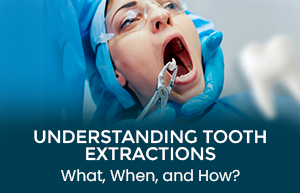
Imagine, you’re having your favorite snack, and before you know it, a stinging pain shoots across your mouth. Or perhaps you’ve been experiencing a throbbing, lingering pain that doesn’t quit regardless of what you try. Tooth pain is not only frustrating, it can ruin your entire day by making eating, speaking, and even sleeping painful.
Sometimes, the best solution isn’t just a filling or a root canal. Sometimes, the tooth has to go.
Tooth extractions might sound scary, but they’re routine procedures that prevent pain and bigger issues. Whether it’s decay, wisdom tooth trouble, or a step before dental implants, extractions have a purpose.
But what actually happens during the procedure? And what should you expect afterward? Let’s break it down.
What is a Tooth Extraction?
A tooth extraction, also known as dental extraction, is the process of removing a tooth from its socket in the jawbone. Dentists always attempt to save a tooth if at all possible, but sometimes extracting it is the only way to ensure overall oral health. A properly done procedure ensures a healthy extracted tooth site which reduces the risk of complications.
People often search for teeth extractions near me when dealing with severe pain, infection, or crowding. And while it might sound intimidating, modern dental techniques make the process quick & comfortable.

When is a Tooth Extraction Necessary?
Tooth extractions are not the first choice when it comes to dental treatment. Dentists always try to save natural teeth through fillings, root canals, or crowns whenever possible. However, in certain cases, removing a tooth is the best or only option to maintain oral health.
Here are some common situations where tooth extractions become necessary:
1. Serious Tooth Decay or Damage:
When a tooth is extensively decayed or damaged beyond repair, even a root canal or crown may not be enough to save it. Extraction is then required to avoid additional pain and infection in such cases. Postponing it can enable bacteria to travel to adjacent teeth, leading to more severe complications.
2. Dental Infections & Abscesses:
A deep infection in the tooth, also known as a dental abscess, can be extremely painful and dangerous. When the infection reaches the root and the surrounding tissues, it can spread to the jawbone and even into the bloodstream.
If antibiotics or a root canal cannot eliminate the infection, extraction becomes the safest solution.
3. Wisdom Teeth Problems:
Wisdom teeth usually don’t have sufficient space to develop normally which results in impaction, crowding, or infection. Impacted wisdom teeth may result in pain, swelling, and chewing difficulty.
In such cases, removing them is necessary to prevent further dental complications. If you’re struggling with wisdom tooth pain, you may need a dentist’s same-day appointment services to address the issue quickly.
4. Overcrowded or Overlapping Teeth:
In some cases, the teeth are too big for the jaw, causing overcrowding. This makes it challenging for teeth to fit in alignment properly which impacts your bite and general dental health.
Doctors may advise for a tooth to be removed, particularly before orthodontic procedures such as braces, to allow room for proper alignment.
5. Gum Disease & Periodontal Infection:
Advanced gum disease (periodontitis) can weaken the bones and tissues supporting the teeth. If a tooth becomes too loose due to severe gum infection, extraction might be necessary to prevent it from spreading.
In case, you’re experiencing any of these issues, it’s best to visit a Family Dentistry expert for a thorough examination.
How Are Tooth Extractions Done?
Tooth extractions are performed based on the condition of the tooth and its position in the mouth. Generally, there are two types of extractions: simple extractions and surgical extractions.
A professional Dental clinic in Bedford will examine your case and determine the most suitable approach.
Note: Before anything, the dentist will take a closer look at the tooth and surrounding gums. X-rays help determine the best approach for the extraction.
- Simple Extractions: Removing Visible Teeth
A simple extraction is performed when the tooth is visible in the mouth and can be easily removed using forceps. This procedure is typically quick, requiring only local anesthesia. Here’s how it works:
- Numbing the Area: First, the dentist applies a local anesthetic to the gum and the area around it so the patient doesn’t feel pain.
- Loosening the Tooth: Using an instrument called an elevator, the dentist gently moves the tooth back and forth to loosen it from the surrounding gum tissue and ligaments.
- Extracting the Tooth: Once the tooth is sufficiently loosened, it is carefully pulled out with the help of a tool called forceps.
- Controlling Bleeding: Following the removal, a piece of gauze is placed over the socket, and the patient is asked to bite down to help stop the bleeding. This also promotes the development of a blood clot, which is essential for healing.
- Providing Aftercare Instructions: The dentist will provide instructions on how to care for the extraction site which you will need to follow.
- Surgical Extractions: Removing Impacted or Broken Teeth
A surgical extraction is a more complex procedure, usually required for teeth that are broken, impacted, or not fully erupted. This is common for wisdom teeth or teeth with deep roots. The procedure involves minor oral surgery and may require stitches.
Here’s how it’s done:
- Administering Anesthesia: Depending on the complexity of the case, the dentist may use a local anesthetic, sedation, or even general anesthesia.
If multiple teeth are being removed, sedation helps keep the patient comfortable throughout the treatment. - Making an Incision: For impacted teeth or those below the gum line, a small incision is made in the gum tissue to access the tooth. In some cases, a small portion of bone may need to be removed to fully expose the tooth.
- Breaking the Tooth into Sections: If the tooth is large or deeply rooted, the dentist may divide it into smaller sections. This makes it easier to remove the tooth without damaging the surrounding bone or neighboring teeth.
- Extracting the Tooth: Once the tooth is accessible, the dentist carefully removes each section using specialized instruments.
- Stitches & Blood Clot Formation: After the tooth is removed, the dentist may place stitches to close the surgical site. A gauze pad is then placed over the area to control bleeding and help form a protective blood clot.
- Recovery & Healing: Since surgical extractions involve minor surgery, the recovery process takes longer than simple extractions. Swelling, mild discomfort, and slight bleeding are common for the first few days.
Note: Both simple and surgical extractions are safe and effective when performed by experienced dental professionals. Whether you need a routine extraction or a more complex procedure, a reliable Family Dentistry practice can provide the right treatment plan for you.
Aftercare Tips for Tooth Extractions
Proper care after an extraction ensures smooth healing and prevents complications. Follow these essential tips:
- Bite on Gauze: Apply gentle pressure with a gauze pad to control bleeding. Change it as needed until the bleeding stops, usually within a few hours.
- Avoid Straws & Smoking: Suction movements can dislodge the blood clot which can lead to dry socket, a painful condition that exposes the bone and nerves at the extraction site. Avoid straws, smoking, and spitting for at least 24-48 hours.
- Eat Soft Foods: Stick to soft, easy-to-chew foods like soups, mashed potatoes, yogurt, and smoothies. Avoid anything crunchy or hot for a week that might irritate the site.
- Keep the Area Clean: For the first 24 hours, avoid rinsing. After that, gently rinse with warm salt water to reduce swelling and prevent infection. Brush carefully around the area without disturbing the extraction site.
Following these aftercare tips will help prevent infections and promote faster healing, ensuring a smooth recovery and a healthy extracted tooth site.
What’s Next After the Extraction?
Once a tooth is removed, the next step depends on your specific needs. Some options include:
- Dental implants: A permanent solution for missing teeth.
- Bridges or dentures: Alternative solutions for restoring your smile.
- Letting the gap heal naturally: This is an option if the missing tooth doesn’t affect your bite or speech.
Conclusion
Tooth extractions might sound intimidating, but with the right care and guidance, they don’t have to be a stressful experience. Whether it’s removing a damaged tooth, making space for orthodontic treatment, or dealing with wisdom tooth pain, extractions help protect your overall oral health.
If you need expert dental care, Pleasant Dental is here for you. Whether you’re looking for teeth extractions near me or affordable dental implants, our team is ready to help. You can quickly book an appointment in Euless Texas. We also have a dental clinic in Bedford, Fort Worth, Arlington, and other nearby areas for top-quality care.
Found this blog post helpful? You will also find this post as well: Beyond Cleaning: A Look at the Full Range of Dental Services
Frequently Asked Questions (FAQs):
1. How painful is a tooth extraction?
The procedure itself isn’t painful due to anesthesia, but mild discomfort is common afterward.
2. How long does recovery take?
Most people feel better within a week or two, but full healing takes longer.
3. Can I eat after an extraction?
Yes, but stick to soft foods for a few days like mashed potatoes, avocado, etc. Avoid hot, spicy, or crunchy foods as well.
4. What if my extraction site is still bleeding after a few hours?
Apply gauze and bite down gently. If bleeding persists, contact your dentist.
5. What are my options after an extraction?
You can get affordable dental implants, bridges, or dentures to replace the missing tooth.
